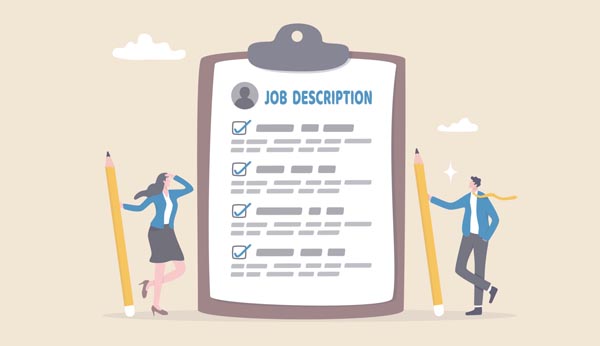When it comes to their position and understanding what is expected of them, individuals rely on a well-crafted job description as an essential tool. It serves as a roadmap, outlining the crucial details of their role and setting the stage for a successful hiring process and long-term employment. Let’s explore the key elements that make up a comprehensive and effective job description.
Job Title
The job title is the first thing that catches the attention of potential candidates. It accurately reflects the individual’s role and level within the organization. A clear and concise job title helps individuals understand the nature of their job and where they fit in the organization. It should be specific enough to convey their core responsibilities while being recognized within the industry.
Job Summary
The job summary provides a brief overview of the position, highlighting its purpose, scope, and relevance within the organization. This section captures attention by presenting an attractive and compelling snapshot of the job. It emphasizes the impact the role has on the company’s goals and the value it brings to the overall mission.
Job Focus
The job focus section delves deeper into the primary areas of responsibility, describing the main tasks and duties associated with the role. It provides individuals with a clear understanding of what they’ll be expected to do on a day-to-day basis. This section outlines the key functions and deliverables, enabling individuals to evaluate their suitability for the position.
Responsibilities and Objectives
This section outlines the specific responsibilities and objectives for which the individuals will be accountable. It provides a comprehensive list of the tasks and projects they’ll be expected to undertake and the goals they are responsible for achieving. Clear and measurable objectives help set expectations for performance and enable individuals to envision their potential impact on the organization.
Expected Outcomes
Highlighting the expected outcomes clarifies the results individuals should aim to accomplish. These outcomes are directly linked to the broader goals and provide individuals with a sense of purpose and direction. Quantifiable metrics or milestones may be provided to help gauge success in meeting these expectations.
Required Competencies
This section outlines the core competencies necessary for the role. It includes the desired skills, required attributes and behaviors that individuals should possess to perform the job effectively. Competencies may range from technical skills to soft skills, such as communication, leadership, problem-solving, or adaptability.
Required Knowledge, Skills, and Abilities
This section provides a detailed breakdown of the education, knowledge, skills, and abilities that individuals must possess or develop to succeed in the role. It aligns with the responsibilities and objectives mentioned earlier in the job description. Specific technical expertise, industry knowledge, or software proficiency that is crucial for the position will be highlighted. The job description will be specific about the minimum requirements and also highlight any preferred qualifications that could set exceptional candidates apart.
Understanding the job description is crucial for success in a position. By including key elements such as the job title, job summary, job focus, responsibilities and objectives, expected outcomes, required competencies, and the necessary knowledge, skills, and abilities, the aim is to provide individuals with a clear understanding of their role and its requirements. A well-written job description not only helps assess fit but also aids in finding the best-suited individuals to drive the organization’s success.




